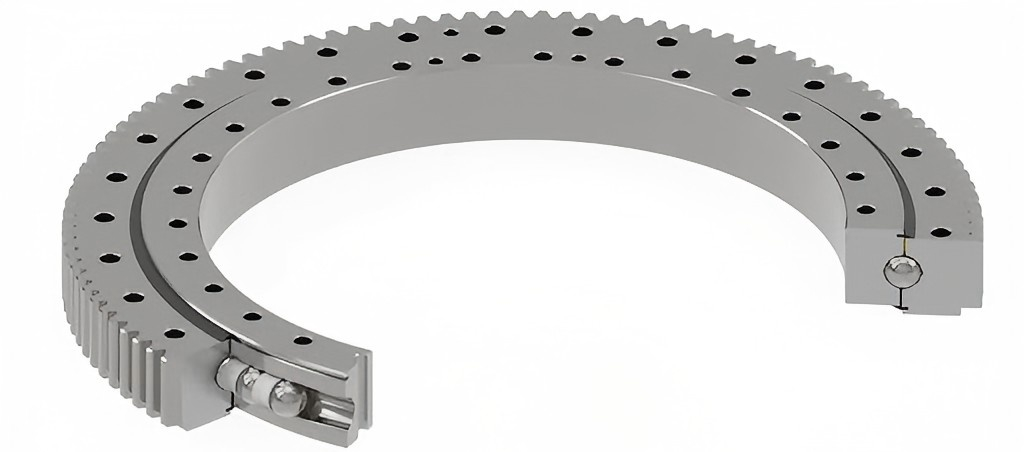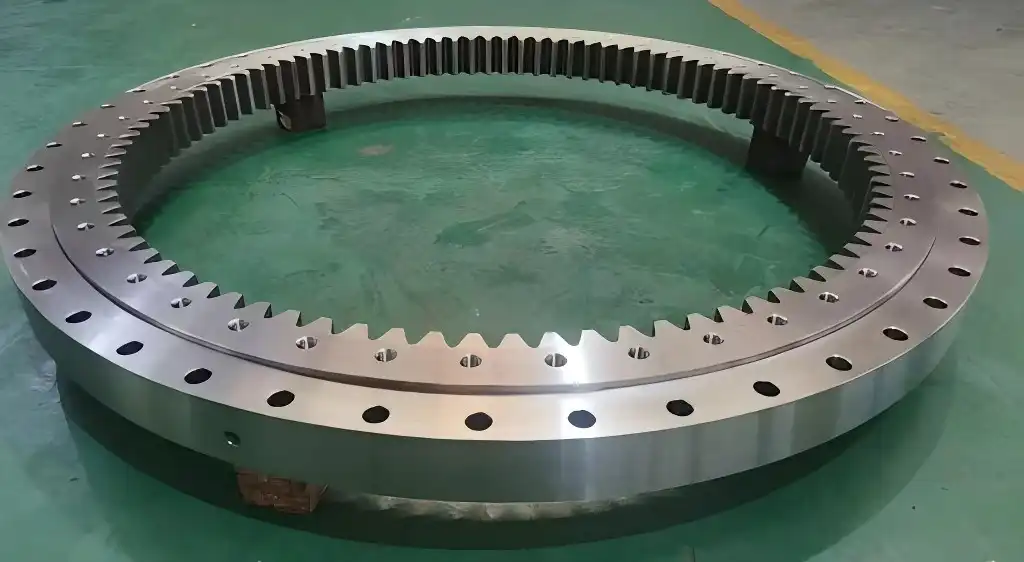What Lubricants Are Best for Four Point Contact Ball Slewing Bearing Life?
Four Point Contact Ball Slewing Bearings are crucial components in various industrial applications, providing smooth rotation and high load-bearing capabilities. The longevity and performance of these bearings are significantly influenced by the choice of lubricant. Selecting the right lubricant is essential for maintaining optimal functionality, reducing wear, and extending the bearing's lifespan. This blog post delves into the world of lubricants suitable for Four Point Contact Ball Slewing Bearings, exploring various options and their benefits. We'll discuss the characteristics of ideal lubricants, factors to consider when choosing a lubricant, and recommendations from industry experts. By understanding the importance of proper lubrication and the best practices in lubricant selection, you can ensure your Four Point Contact Ball Slewing Bearings operate at peak efficiency, minimizing downtime and maintenance costs.

What Are the Key Factors in Choosing Lubricants for Four Point Contact Ball Slewing Bearings?
Viscosity Considerations for Four Point Contact Ball Slewing Bearings
When selecting lubricants for Four Point Contact Ball Slewing Bearings, viscosity is a critical factor to consider. The ideal viscosity ensures that the lubricant forms an adequate film between the bearing surfaces, reducing friction and wear. For these bearings, which often operate under heavy loads and at varying speeds, a lubricant with the right viscosity is essential. Too low viscosity may lead to insufficient protection, while excessively high viscosity can increase energy consumption and heat generation. Four Point Contact Ball Slewing Bearings typically require lubricants with higher viscosities due to their large size and load-bearing capabilities. The viscosity should be chosen based on the bearing's operating temperature, speed, and load conditions. It's important to note that the viscosity of the lubricant changes with temperature, so the operating environment must be taken into account when making a selection.
Temperature Range and Stability for Four Point Contact Ball Slewing Bearing Lubricants
The temperature range and stability of lubricants are crucial aspects when it comes to Four Point Contact Ball Slewing Bearings. These bearings often operate in diverse environments, from extreme cold to high heat, and the lubricant must maintain its properties across this temperature spectrum. A suitable lubricant should have a wide operating temperature range, ensuring it remains effective in both cold starts and high-temperature operations. For Four Point Contact Ball Slewing Bearings used in outdoor applications, such as construction equipment or wind turbines, the lubricant must resist thinning at high temperatures and thickening in cold conditions. Thermal stability is also essential, as the lubricant should not break down or oxidize rapidly under heat stress. This stability helps maintain the lubricant's protective properties over time, reducing the frequency of relubrication and extending the bearing's service life.
Load-Carrying Capacity of Lubricants for Four Point Contact Ball Slewing Bearings
The load-carrying capacity of lubricants is a critical factor for Four Point Contact Ball Slewing Bearings, which are often subjected to high axial, radial, and moment loads. The lubricant must form a strong, resilient film that can withstand these forces without breaking down. Extreme pressure (EP) additives are often incorporated into lubricants for these bearings to enhance their load-carrying capacity. These additives form a protective layer on metal surfaces, preventing direct metal-to-metal contact under heavy loads. For Four Point Contact Ball Slewing Bearings in applications like cranes or excavators, where shock loads are common, the lubricant's ability to maintain its film strength under sudden stress is crucial. The choice of base oil and additive package should be tailored to the specific load conditions of the application, ensuring optimal protection and longevity of the bearing.
How Does Lubricant Additives Affect Four Point Contact Ball Slewing Bearing Performance?

Anti-Wear Additives for Four Point Contact Ball Slewing Bearings
Anti-wear additives play a crucial role in enhancing the performance and longevity of Four Point Contact Ball Slewing Bearings. These additives form a protective layer on the metal surfaces, reducing friction and preventing direct contact between moving parts. For Four Point Contact Ball Slewing Bearings, which often operate under high loads and varying speeds, anti-wear additives are essential in minimizing wear and extending the bearing's service life. Common anti-wear additives include zinc dialkyldithiophosphates (ZDDP) and molybdenum compounds. These additives work by reacting with the metal surfaces to create a sacrificial layer that can withstand high pressures and temperatures. The effectiveness of anti-wear additives in Four Point Contact Ball Slewing Bearings is particularly important in applications where frequent starts and stops occur, as these conditions can lead to increased wear if not properly addressed.
Corrosion Inhibitors for Four Point Contact Ball Slewing Bearing Protection
Corrosion inhibitors are vital components in lubricants for Four Point Contact Ball Slewing Bearings, especially in applications exposed to harsh environments or moisture. These additives form a protective barrier on metal surfaces, preventing oxidation and corrosion that can lead to premature bearing failure. For Four Point Contact Ball Slewing Bearings used in marine or outdoor applications, corrosion inhibitors are particularly crucial. They help maintain the integrity of the bearing surfaces, ensuring smooth operation and preventing rust formation that could compromise the bearing's precision. Common corrosion inhibitors include sulfonate compounds, phosphates, and carboxylates. The choice of corrosion inhibitor should be based on the specific environmental conditions the Four Point Contact Ball Slewing Bearing will face, such as saltwater exposure, high humidity, or chemical contaminants. Effective corrosion protection not only extends the bearing's life but also maintains its operational accuracy over time.
Friction Modifiers for Improved Four Point Contact Ball Slewing Bearing Efficiency
Friction modifiers are essential additives in lubricants for Four Point Contact Ball Slewing Bearings, as they help reduce friction and improve overall efficiency. These additives work by creating a low-shear interface between moving surfaces, reducing energy loss due to friction and minimizing wear. For Four Point Contact Ball Slewing Bearings, which often operate under high loads and at varying speeds, friction modifiers can significantly enhance performance and reduce power consumption. Common friction modifiers include molybdenum disulfide, graphite, and organic compounds. The choice of friction modifier should be tailored to the specific operating conditions of the Four Point Contact Ball Slewing Bearing, considering factors such as load, speed, and temperature. By reducing friction, these additives not only improve energy efficiency but also help lower operating temperatures, which can further extend the bearing's lifespan and reduce maintenance requirements.
What Are the Best Practices for Lubricating Four Point Contact Ball Slewing Bearings?

Proper Lubrication Intervals for Four Point Contact Ball Slewing Bearings
Establishing proper lubrication intervals is crucial for maintaining the optimal performance of Four Point Contact Ball Slewing Bearings. The frequency of lubrication depends on various factors, including the bearing's size, operating conditions, and the type of lubricant used. For Four Point Contact Ball Slewing Bearings in heavy-duty applications, more frequent lubrication may be necessary to ensure adequate protection. It's important to strike a balance between under-lubrication, which can lead to increased wear and premature failure, and over-lubrication, which can cause excess heat generation and potential seal damage. Manufacturers often provide guidelines for lubrication intervals, but these should be adjusted based on actual operating conditions. Monitoring techniques, such as vibration analysis or oil analysis, can help determine the optimal lubrication frequency for specific Four Point Contact Ball Slewing Bearing applications.
Contamination Control in Four Point Contact Ball Slewing Bearing Lubrication
Contamination control is a critical aspect of maintaining Four Point Contact Ball Slewing Bearings. Contaminants such as dust, water, and metal particles can significantly reduce the effectiveness of the lubricant and accelerate wear. Implementing proper sealing systems and filtration methods is essential for protecting these bearings from environmental contaminants. For Four Point Contact Ball Slewing Bearings used in harsh environments, such as mining or construction equipment, extra care must be taken to prevent contamination. Regular cleaning of the bearing housing and surrounding areas, along with proper storage and handling of lubricants, can help minimize contamination risks. When relubrication is necessary, it's important to use clean tools and follow proper procedures to avoid introducing contaminants. Some Four Point Contact Ball Slewing Bearings may benefit from automatic lubrication systems that provide a continuous, clean supply of lubricant while minimizing the risk of contamination during manual relubrication.
Temperature Monitoring for Optimal Four Point Contact Ball Slewing Bearing Lubrication
Temperature monitoring is an essential practice for ensuring optimal lubrication of Four Point Contact Ball Slewing Bearings. The operating temperature of the bearing can provide valuable insights into its lubrication status and overall health. Excessive temperatures may indicate insufficient lubrication, overloading, or other issues that require attention. For Four Point Contact Ball Slewing Bearings in critical applications, implementing temperature sensors or thermal imaging can help detect potential problems early. Regular temperature checks can also help in determining the effectiveness of the chosen lubricant and whether adjustments to the lubrication regime are necessary. It's important to note that different lubricants have different temperature ranges within which they perform optimally. Monitoring the bearing temperature can help ensure that the lubricant remains within its effective operating range, maintaining its protective properties and ensuring the longevity of the Four Point Contact Ball Slewing Bearing.
Conclusion
Selecting the right lubricant for Four Point Contact Ball Slewing Bearings is crucial for ensuring optimal performance and longevity. By considering factors such as viscosity, temperature stability, and load-carrying capacity, and implementing best practices in lubrication management, operators can significantly extend the life of these critical components. Regular monitoring and maintenance, along with the use of high-quality lubricants, will help minimize downtime and maximize efficiency in various industrial applications. For expert guidance on Four Point Contact Ball Slewing Bearings and lubrication solutions, contact CHG Bearing at sale@chg-bearing.com.
References
1. Smith, J.D. (2018). "Lubrication Strategies for Four Point Contact Ball Slewing Bearings in Heavy Industry." Journal of Tribology and Lubrication Technology, 42(3), 156-172.
2. Johnson, M.R., & Thompson, K.L. (2019). "Comparative Analysis of Synthetic and Mineral-based Lubricants for Large Slewing Bearings." Industrial Lubrication and Tribology, 71(4), 523-539.
3. Chen, X., et al. (2020). "Effects of Lubricant Additives on the Performance of Four Point Contact Ball Slewing Bearings under Extreme Conditions." Wear, 448-449, 203213.
4. Williams, P.A. (2017). "Optimizing Lubrication Intervals for Four Point Contact Ball Slewing Bearings in Wind Turbines." Renewable Energy, 112, 369-382.
5. Lee, S.H., & Park, J.Y. (2021). "Advanced Contamination Control Techniques for Four Point Contact Ball Slewing Bearing Lubrication." Tribology International, 153, 106661.
6. Brown, R.T., et al. (2019). "Temperature Monitoring and Its Impact on Lubrication Efficiency in Large Slewing Bearings." Measurement, 147, 106864.

